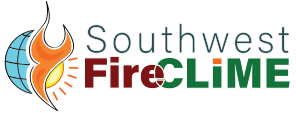
Resource Catalog
Document
We related measurements of annual burned area in the southwest United States during 1984-2013 to records of climate variability. Within forests, annual burned area correlated at least as strongly with spring-summer vapour pressure deficit (VPD) as with 14 other drought-related metrics, including more complex metrics that explicitly represent fuel moisture. Particularly strong correlations with VPD arise partly because this term dictates the atmospheric moisture demand. Additionally, VPD responds to moisture supply, which is difficult to measure and model regionally due to complex micrometeorology, land cover and terrain. Thus, VPD appears to be a simple and holistic indicator of regional water balance. Coupled with the well-known positive influence of prior-year cold season precipitation on fuel availability and connectivity, VPD may be utilised for burned area forecasts and also to infer future trends, though these are subject to other complicating factors such as land cover change and management. Assuming an aggressive greenhouse gas emissions scenario, climate models predict mean spring-summer VPD will exceed the highest recorded values in the southwest in nearly 40% of years by the middle of this century. These results forewarn of continued increases in burned forest area in the southwest United States, and likely elsewhere, when fuels are not limiting.
Cataloging Information
- area burned
- climate variability
- climatology
- cover
- drought
- energy
- fire danger
- fire danger rating
- fire management
- fire size
- fuel management
- fuel moisture
- moisture
- mortality
- precipitation
- range management
- tree mortality
- warming
- water
- water balance
- wildfires

This bibliographic record was either created or modified by Tall Timbers and is provided without charge to promote research and education in Fire Ecology. The E.V. Komarek Fire Ecology Database is the intellectual property of Tall Timbers.
